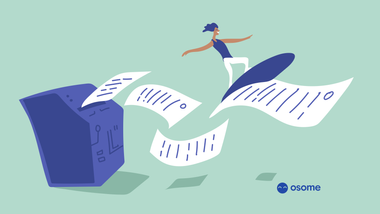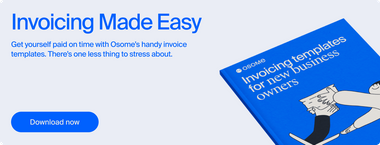The Only Guide You Need To Create Your First Invoice
Simple invoices can help save time with all basic accounting details you require to bill clients for your work. Think of them as organised documents that are easy to understand and create.

Just registered your business in Singapore? Congratulations! It’s time to move on to the next step - the billing. If you are confused about how to create an invoice to bill your clients, fret not. Simple invoices can help save time with all basic accounting details you require to bill clients for your work. Think of them as organised documents that are easy to understand and create.
Here's the good news - the process is pretty simple, and once you get the hang of it, you can streamline the task with a base template. This is what you need to know about creating an invoice.
What Is an Invoice?

An invoice, sometimes also known as a bill or sales invoice, is a document sent out by a business as proof of a transaction, and to ask for payment for a service or product provided.
What Do I Need To Include in an Invoice?
Being fairly remunerated for your work is important, but getting paid on time is also crucial to avoid cash flow problems. A well-designed invoice makes all the difference in making sure you get paid in a timely manner without complication from unclear information.
Here’s what you should include to make your invoice look professional with all the essential information, so your clients can make payment easily.
Company name
The first step in creating an invoice would be to include your company name, the most important element in your invoice. It reflects who you are and validates your brand. For an extra touch, you can even create a company logo using simple design tools such as Canva.
Contact information
Remember to include your name, phone number, email address and address. This information allows your clients to contact you should there be any clarifications regarding the invoice, and it also gives them the opportunity to get in touch with you for future work.
Do the same for your client in a ‘Bill To:’ section, with your client’s contact information, detailing their billing contact name, phone number, email address and address.
Invoice date
Cultivate the habit of including the invoice date for every invoice you create. This will make filing invoices a lot more fuss free, for you and your clients.
Invoice number
Establish a simple invoice numbering system in which you assign every invoice a unique invoice number. You’ll thank us for it later -- this will help you stay organised and track your invoices for bookkeeping purposes a lot easier, especially when it comes to tax season. It will also be a lot more straightforward when you have to discuss a particular invoice with a client.
Don’t crack your brains over the invoice numbering, it can be as easy as numbering them sequentially. For instance, the first invoice you send can be #01, with the subsequent one being #02 and so on.
Outline the provided services or goods
If you are a service provider, list the services rendered to your client so it is easier for the both of you to keep track. Start by inserting a basic table with four columns, detailing the following:
- A brief description of the service provided
- The number of man hours or the work quantity
- The remuneration
- The subtotal for each service
If you have provided more than one service, feel free to add additional rows in the table.
Elizabeth manages digital media agency OUTRAGED, and provides graphic design services for her client. At the end of the month, Elizabeth creates her invoices, detailing the services provided:
| Service Provided | Number of man hours | Remuneration (per hour) | Subtotal |
|---|---|---|---|
| Graphic design for website | 10 | $50 | $500 |
If you are selling products, the description of goods forms the most crucial part of the invoice. Similar to invoicing for your service, it is important to split your invoice into at least four separate columns: quantity, description, unit price, as well as line total.
Stephanie sells her own handmade accessories online. Whenever she gets an order, she will create an invoice to detail the following:
| Quantity | Description | Unit Price | Line Total |
|---|---|---|---|
| 3 | Emma Bracelet | $20 | $60 |
Payment terms
Small businesses typically adopt these three main types of payment terms, in line with common industry practices. It is also dependent on your cash flow needs, and your relationship with the client. Some of the common invoice payment terms include:
- Net (N)
Net 10’ would imply that the full payment amount is due within 10 days, while ‘Net 30’ would mean 30 days after the invoice date. ‘Net’ can also be abbreviated to ‘N’, so N10 or N30 would appear on the invoice.
- Payment in advance (PIA)
When working with new clients or clients with late payment history, payment in advance (PIA) could be a good method to deal with them. Under this payment term, your client will have to make the payment in full before they receive your goods or services.
- End of Month (EOM)
This means that the full amount of payment has to be made within the amount of days stated after the invoice issuance month-end. In your invoice, this can be written as, ‘Payment due 30 days month-end’ or abbreviated to ‘Net EOM 30’. For instance, if your invoice was dated 7 March and your payment terms were ‘Payment due 30 days month-end’, then you should be expecting the full payment by 30 April.
- Month following invoice (MFI)
If you are expecting the full amount to be made on the first 15th of the month upon invoice issuance, your payment term can be abbreviated to ‘15 MFI’. For instance, if your invoice date was 7 February with the payment term 15 MFI, the payment would be due on 15 February. However, if the same invoice was dated 16 February, then the payment would only be due on the 15th of the following month, which is 15 March.
Some companies may make payment later than the due date stated, so you should factor these in and take measures to bridge your cash flow gap.
On each invoice, briefly explain your payment terms and late fee policy if you intend to bill clients for late payment. Detail your accepted payment methods, which could be made with a combination of the following:
- Cash
- Credit card
- Cheques
- Online payments
- Bank transfer
- Mobile payments
- Recurring payments
Discounts
If your relationship with your client is a long-standing one, you may want to offer a goodwill discount. This discount should be included within the invoice, and can be an actual amount or a percentage.
Goods and Services Tax (GST)
If your company is registered for GST, you will have to issue a tax invoice or customer accounting tax invoices for your standard-rated supplies. If the total payable amount (including GST) does not surpass $1,000, you may send out a simplified tax invoice. Make sure that your GST Registration Number is reflected on all your tax invoices, simplified tax invoices and receipts.
Amount due and due date
Clearly state the total amount due (including any applicable taxes) at the bottom of your invoice, with the payment due date. For easy readability, you may want to use a different font colour or a bold font. To avoid confusing your client, jot down the payment deadline as a specific date e.g. “Payment due November 14, 2020”.
Including the due date on your invoice serves as a professional and tactful manner of informing your client when they should pay. In addition, you can also set up payment reminders to ensure your clients make timely payments.
What Tools Can I Use To Create an Invoice?
When it comes to generating an invoice, you have so many options to choose from. From services to invoicing software programs, you can take your pick.
Alternatively, simple tools like Google Docs or Microsoft Word can do the trick. with a variety of professional-looking templates available for your usage so you don't have to start from scratch to create your own.
Automate Your Invoices and Be On Top of your Financial Data
Keeping up with the status of your payments can be draining and distract you from the core business of your company. Put your time to better use and focus on building your business - just leave the bookkeeping and accounting to us at Osome.







